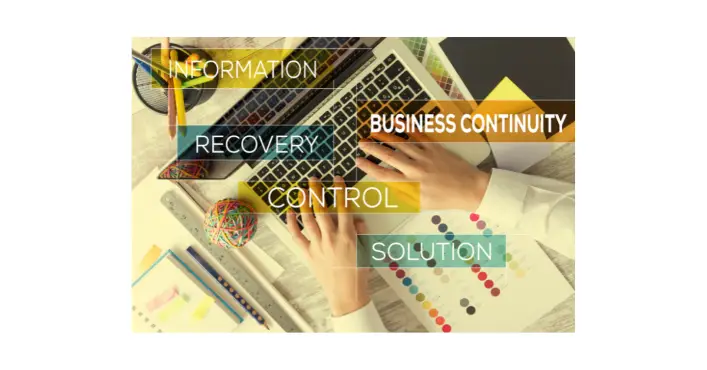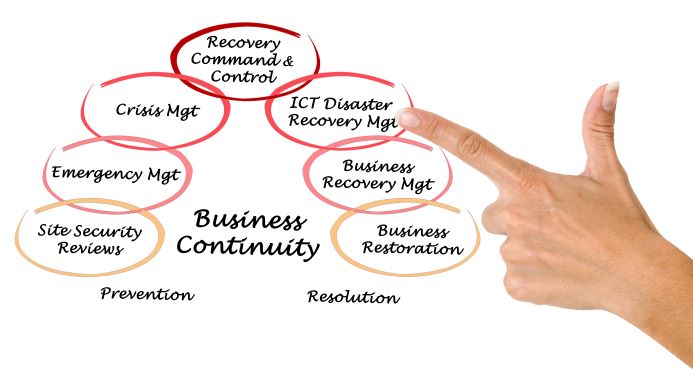Business continuity is an organization’s ability to maintain its operations and critical functions in the face of disruptive events. Includes maintaining essential personnel, systems, and facilities and ensuring the safety of employees and customers.
A well-designed continuity plan will allow an organization to quickly resume operations following a disruption.
The key to successful business continuity is identifying which functions are essential to the operation of the business and developing plans to maintain these functions in the event of a disruption.
Taking these steps, companies can minimize the impact of disruptive events and ensure that they can resume operations quickly.
The key to developing a successful business continuity plan is anticipating disruptions that could adversely impact your operations. While it is impossible to predict every possible scenario, some types of disruptive events are more likely to occur than others.
For example, natural disasters such as hurricanes, floods, and earthquakes can cause widespread damage and disrupt supply chains.
Similarly, pandemics and other public health emergencies can lead to employee absenteeism and customer aversion. Other potential disruptions include cyberattacks, data breaches, and power outages.
Identifying the events that pose the most significant risk to your business, you can develop a continuity plan that will help keep your operations up and running in unexpected challenges.
Business continuity management (BCM) is a framework for identifying an organization’s risk of exposure to internal and external threats.
BCM encompasses all the resources, processes, and information needed to maintain or resume operations in the event of an incident.
BCM aims to minimize the impact of an interruption on business operations and protect the safety of employees, customers, and other stakeholders.
BCM comprises four interrelated components: risk assessment, business impact analysis, contingency planning, and crisis management.
Risk assessment is the process of identifying and assessing risks to the organization. Business impact analysis is the process of determining the potential consequences of an interruption to business operations.
Contingency planning is the development of plans and procedures to enable the organization to continue or resume operations in an incident. Crisis management is managing an incident and its effects on the organization.
This blog post will outline all the fundamental components of business continuity management so that you can develop your comprehensive plan.

Risk Assessment
Risk assessment is an essential part of business continuity management. By identifying potential risks and their impacts, businesses can develop plans to mitigate or prevent them.
Risk assessment involves four steps: identification, analysis, evaluation, and treatment. First, potential risks are identified through thoughtful brainstorming and research.
Second, the team analyzes each risk to determine its probability and potential impact. Third, the team evaluates the risks and decides which ones warrant further attention.
Finally, the team develops plans to address the identified risks. By taking these steps, businesses can ensure they are prepared for potential disruptions.
Risk assessment aims to identify potential threats to an organization and establish plans to mitigate those threats.
Risk assessment is a critical part of business continuity management, as it helps organizations identify and plan for disruptions that could impact their operations. By understanding the risks they face, organizations can develop contingency plans to help them continue functioning in an incident.
Risk assessment also provides a basis for developing business continuity training and testing programs, which can help organizations to be better prepared for disruptions.
Ultimately, risk assessment is vital for ensuring that businesses can survive and thrive in the face of potential disasters.
Making decisions can be difficult, especially when a lot is at stake. To help make the best choices, businesses use risk assessments.
This process involves identifying potential risks, estimating their likelihood, and evaluating the potential impact. With this information, businesses can develop strategies to mitigate or avoid risks.
Risk assessment can be used in various situations, from choosing which products to develop to deciding whether to enter a new market. Businesses can make informed decisions that help them avoid problems by assessing risks.
Business Impact Analysis
A key component of BCM is business impact analysis (BIA), which identifies and assesses the potential effects of disruptions on business operations.
The goal of BIA is to provide information that can be used to develop and implement strategies for maintaining continuity of operations.
BIAs are typically conducted regularly as part of the overall process of monitoring and updating BCM plans. By periodically assessing the potential impacts of disruptions, businesses can be better prepared to maintain operations in an interruption.
Business impact analysis involves identifying and assessing the potential effects of disruptions on business operations.
The goal is to ensure adequate plans and resources are in place to minimize the impact of disruptions and ensure timely recovery. The first step in business impact analysis is to identify the critical functions of the business.
These activities must be performed to maintain operations and meet customer requirements. Once the critical functions have been identified, the next step is to assess the potential effects of disruptions on these functions.
Includes identifying the resources required for each process and estimating the time needed for recovery. The final step is to develop plans and procedures to minimize the impact of disruptions and ensure timely recovery.
Benefits of Business Impact Analysis
- Improved Organizational Resilience: By identifying and assessing the potential impacts of disruptions, organizations can make strategic decisions to improve their resilience.
- Improved Risk Management: Business impact analysis provides a structured approach to identify and assess the risks associated with disruptions. The information can then be used to develop and implement strategies to mitigate or minimize those risks.
- Enhanced Communication and Coordination: Business impact analysis can help improve communication and coordination among different levels of an organization in the event of a disruption. Identifying who needs to be notified and when BIA can help ensure everyone is on the same page and working towards the same goal.
- More Informed Decision Making: As previously mentioned, business impact analysis provides organizations with valuable information about the potential impacts of disruptions. This information can then be used to make more informed decisions about preparing for and responding to those disruptions.
- Improved Business Continuity Planning: Business continuity planning is essential for disaster preparedness efforts. By identifying the critical functions of an organization and the resources required to maintain those functions, BIA can help organizations develop comprehensive and effective continuity plans.
- Increased Customer Satisfaction: Customer satisfaction is more important than ever in today’s competitive business environment. By minimizing the impact of disruptions on customers, businesses can ensure that their customers remain satisfied with their products.
Contingency Planning
Contingency planning is a crucial part of business continuity management. By definition, contingency planning is creating a plan to deal with potential emergencies or disruptions.
The goal of contingency planning is to minimize an unforeseen event’s impact and ensure that business operations can resume as quickly as possible.
A good contingency plan will consider potential disruptions, from natural disasters to power outages to terrorism. Furthermore, a contingency plan should be regularly updated and tested to ensure effectiveness.
While no one likes to think about worst-case scenarios, contingency planning is essential for protecting your business in an emergency.
The goal of contingency planning is to minimize the impact of a disruption and ensure that the organization can resume operations as quickly as possible. Contingency plans typically include alternate sites, backup systems, and disaster recovery provisions.

Benefits of contingency plans
- Mitigates risk of unexpected events.
- Prevents or limits damages from occurring.
- Eases decision-making during unforeseen crises.
- Enables swift reaction to sudden opportunities or threats.
- Provides clarity in chaotic situations
Crisis Management
Crisis management is an integral part of business continuity management. It is the process of planning for and responding to incidents that could disrupt business operations.
Crisis management plans should be designed to address both internal and external threats. They should identify potential risks, determine the steps to mitigate them and establish procedures for responding to disruptions.
Effective crisis management requires close coordination between different departments within an organization.
It also requires regular training and exercises to ensure everyone understands their roles and responsibilities; organizations can improve their chances of quickly weathering a crisis and returning to normal operations.
Crisis management plans should be tailored to the specific needs of the company and the types of crises that are most likely to occur.
The plan should include steps for communication, incident response, and recovery. Companies can minimize the damage caused by a crisis and ensure they can continue operations.
A crisis management plan is a critical tool for any business. An effective crisis management plan will help a company minimize the damage caused by a crisis and ensure that the company can continue operations.
A well-designed crisis management plan can help a company to:
- Communicate effectively with employees, customers, and other stakeholders.
- Respond quickly and effectively to an incident.
- Recover from the effects of a crisis.
There are many different factors to consider when designing a crisis management plan. The specific needs of the company and the types of crises that are most likely to occur should be taken into account.
The plan should include steps for communication, incident response, and recovery.

Conclusion
So, what exactly is business continuity management? In short, an organization can maintain its operations and critical functions in the face of disruptive events. The four interrelated components of BCM are risk assessment, business impact analysis, contingency planning, and crisis management.
By considering all these fundamentals, you can develop a continuity plan that will allow your organization to resume normal operations quickly following a disruption.
Have you ever had to put your business continuity plan into action? If so, we’d love to hear about your experience in the comments below.

Chris Ekai is a Risk Management expert with over 10 years of experience in the field. He has a Master’s(MSc) degree in Risk Management from University of Portsmouth and is a CPA and Finance professional. He currently works as a Content Manager at Risk Publishing, writing about Enterprise Risk Management, Business Continuity Management and Project Management.

